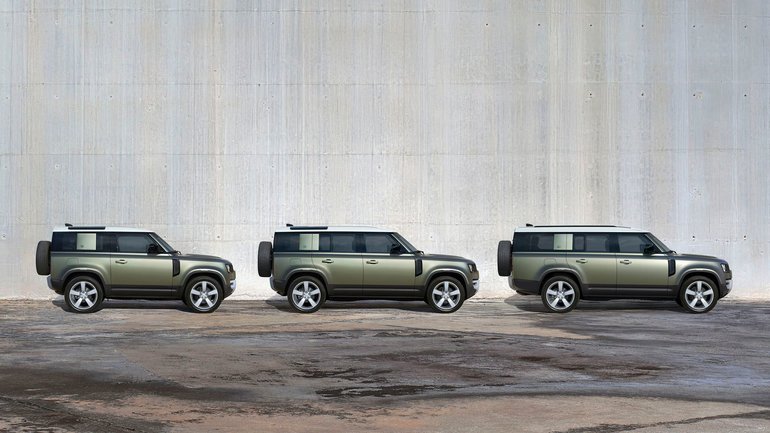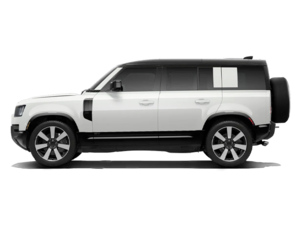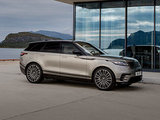Comparing the 2026 Defender 90, 110, and 130: Cargo, Seating, and Off-Road Ability
October 29 2025,

Shopping for a Land Rover Defender in Victoria means choosing between three very different sizes: the compact 90, the versatile 110, and the extended 130. Each model delivers the same legendary off-road ability and premium British design, but the differences in seating, cargo space, and daily practicality are significant.
If you're confused about which Defender suits your Vancouver Island life, this guide breaks down the key differences to help you decide.
Understanding the Three Body Styles
The 2026 Defender lineup offers three distinct configurations. The 90 is the two-door model, the 110 adds a second row of doors and optional third-row seating, and the 130 stretches the wheelbase further to provide standard three-row seating for up to eight passengers.
Here's how they compare at a glance:
Defender 90:
- Seating: 5 passengers
- Doors: 2
- Cargo space: 297 litres behind row 2, up to 1,651 litres maximum
- Overall length: 4,582 mm
- Starting price: $79,050
Defender 110:
- Seating: 5–7 passengers
- Doors: 4
- Cargo space: 303 litres (with third row) / 963 litres (rows 2+3 folded) / up to 2,233 litres maximum
- Overall length: 5,019 mm
- Starting price: $80,650
Defender 130:
- Seating: Up to 8 passengers
- Doors: 4
- Cargo space: 433 litres behind row 3 / up to 2,516 litres maximum
- Overall length: 5,377 mm
- Starting price: $90,400
The 110 sits in the middle, offering the most flexible seating and cargo arrangements. The 130 adds nearly 360 mm of length over the 110, all of it dedicated to third-row passenger space.
Defender 90: Urban Agility for Victoria Couples
The Defender 90 is the shortest and most manoeuvrable option. With just two doors and a 2,588 mm wheelbase, it handles city parking and narrow trails with ease.
This model works well for couples or small families who prioritise driving dynamics over maximum cargo room. The 90's compact footprint makes it ideal for navigating downtown Victoria, squeezing into tight parking spots near the Inner Harbour, or tackling technical forest service roads where a longer vehicle might struggle.
Cargo space behind the second row measures 297 litres, which is enough for groceries, gym bags, or a weekend's worth of camping gear. Fold the rear seats flat and you gain 1,651 litres of space—sufficient for bikes, kayaks, or a full load of home improvement materials.
The 90's shorter rear overhang improves departure angles on steep terrain, making it the best choice if you regularly explore rugged trails around Sooke or the Malahat backcountry.
Engine options include the P300 powertrain with a 2.0-litre turbocharged four-cylinder producing 296 horsepower and 295 lb-ft of torque. Step up to the P400 mild-hybrid six-cylinder for 395 horsepower and 406 lb-ft, or choose the V8 for 518 horsepower and serious performance. An eight-speed automatic transmission and twin-speed transfer case come standard across all powertrains.
Defender 110: The Balanced Choice for Active Families
The Defender 110 adds two rear doors and a longer cabin, making it the most versatile option in the lineup. This model is designed for families who need more seating flexibility without committing to the 130's larger size.
Standard seating is for five, with 991 mm of second-row legroom—considerably more than the 90's 930 mm. Opt for the available third row and you can squeeze in two additional passengers for short trips, though those seats work best for kids.
Cargo space is where the 110 shines. With all seats in use, you have 303 litres of storage. Fold the third row flat and cargo capacity jumps to 963 litres. Drop the second row as well and you're looking at 2,233 litres of maximum space—enough to haul surfboards, camping gear, and a family's worth of luggage to Tofino or Parksville.
The 110's 3,023 mm wheelbase strikes a balance between off-road capability and on-road comfort. It's long enough to smooth out rough pavement but short enough to handle tight switchbacks on logging roads.
Engine options for the 110 include the P300 four-cylinder (296 horsepower, 295 lb-ft), the P400 mild-hybrid six-cylinder (395 horsepower, 406 lb-ft), and the V8 (518 horsepower, 461 lb-ft). The P400 pairs a 3.0-litre turbocharged six-cylinder engine with mild-hybrid technology, delivering stronger acceleration and better towing capacity than the P300. The V8 transforms the 110 into a high-performance SUV capable of reaching 100 km/h in approximately 5.2 seconds.
Defender 130: Maximum Space for Gear-Heavy Lifestyles
The Defender 130 is the longest model in the range, built specifically for buyers who need three rows of seating and serious cargo capacity. This is the option for families of five or more, or anyone who regularly hauls bulky equipment.
Standard seating is for eight passengers across three rows. The third row is designed for adults, not just kids, with 975 mm of legroom—far more than the 110's cramped third-row setup. Even with all three rows occupied, you still have 433 litres of cargo space behind the third row.
Fold the third row flat and cargo volume increases to 1,015 litres. Drop the second row as well and you unlock 2,516 litres of maximum capacity—the most in the Defender lineup. This is the model for extended camping trips, moving furniture, or transporting sports teams.
The 130's extended length doesn't compromise off-road ability. Ground clearance, approach angle, and departure angle remain competitive, and the twin-speed transfer case with low-range gearing handles steep inclines and technical terrain without issue.
Engine options include the P300 six-cylinder (296 horsepower, 347 lb-ft), the P400 mild-hybrid six-cylinder (395 horsepower, 406 lb-ft), and the V8 (493 horsepower, 461 lb-ft). The 130 also features electronic air suspension and adaptive dynamics as standard equipment, improving ride quality on long highway drives. Note that the V8 produces slightly less power in the 130 compared to the 90 and 110 models.
Comparing Cargo Capacity: Which One Handles Your Gear?
Cargo space varies significantly across the three models. Here's how they stack up for common Vancouver Island scenarios:
Weekend trip to Tofino (surfboards, wetsuits, camping gear):
- Defender 90: Tight but doable for two people
- Defender 110: Comfortable for a family of four
- Defender 130: Room for extended family plus all their equipment
Home Depot run (lumber, tools, gardening supplies):
- Defender 90: 1,651 litres max (fold rear seats)
- Defender 110: 2,233 litres max (fold all rear seats)
- Defender 130: 2,516 litres max (fold all rear seats)
Daily commute (laptop bag, gym gear, groceries):
- Defender 90: 297 litres (adequate for one or two people)
- Defender 110: 303 litres with third row / 963 litres without
- Defender 130: 433 litres (plenty of room even with all seats up)
The 110 offers the best balance for most buyers. You get more cargo flexibility than the 90 without the added bulk of the 130.
Seating Flexibility: Who Rides Comfortably?
Seating capacity and comfort differ across the three models:
Defender 90:
- Front row: 1,030 mm headroom, 991 mm legroom
- Second row: 981 mm headroom, 930 mm legroom
- Best for: Couples, solo adventurers, or families with one or two young kids
Defender 110:
- Front row: 1,030 mm headroom, 991 mm legroom
- Second row: 1,025 mm headroom, 975 mm legroom (five-seat config)
- Optional third row: 1,025 mm headroom, 975 mm legroom (cramped for adults)
- Best for: Families of three to five who occasionally need extra seats
Defender 130:
- Front row: 1,030 mm headroom, 975 mm legroom
- Second row: 1,025 mm headroom, 975 mm legroom
- Third row: 1,025 mm headroom, 975 mm legroom (adult-friendly)
- Best for: Families of five or more, carpool duties, or frequent group outings
The 130's third row is the only one comfortable for adults on longer trips. The 110's optional third row works fine for kids or short drives around town, but taller passengers will feel cramped on the highway to Nanaimo or Port Alberni.
Engine Options and Performance
All three Defender models offer multiple powertrains, from efficient four-cylinders to high-performance V8s:
Defender 90:
- P300: 2.0L turbo four-cylinder, 296 hp, 295 lb-ft
- P400: 3.0L turbo six-cylinder mild-hybrid, 395 hp, 406 lb-ft
- V8: 5.0L supercharged V8, 518 hp, 461 lb-ft
Defender 110:
- P300: 2.0L turbo four-cylinder, 296 hp, 295 lb-ft
- P400: 3.0L turbo six-cylinder mild-hybrid, 395 hp, 406 lb-ft
- V8: 5.0L supercharged V8, 518 hp, 461 lb-ft
Defender 130:
- P300: 3.0L turbo six-cylinder, 296 hp, 347 lb-ft
- P400: 3.0L turbo six-cylinder mild-hybrid, 395 hp, 406 lb-ft
- V8: 5.0L supercharged V8, 493 hp, 461 lb-ft
The P400's mild-hybrid system recovers energy during braking and assists acceleration, improving fuel efficiency in stop-and-go traffic. The V8 option transforms any Defender into a high-performance SUV with exhilarating acceleration—the 90 and 110 V8 models reach 100 km/h in approximately 5.2 seconds. All engines pair with an eight-speed automatic transmission and full-time all-wheel drive.
Towing capacity reaches approximately 3,500 kg across the lineup when properly equipped, with V8 models capable of towing up to 3,720 kg (8,200 lbs). The P400 and V8's extra torque makes towing trailers or boats feel less laboured on steep Island grades.
Off-Road Capability: Does Size Matter?
All three Defenders include Terrain Response, a twin-speed transfer case, and hill descent control. Ground clearance, wading depth, and off-road tech are consistent across the range.
The 90's shorter wheelbase and tighter turning radius give it an edge on narrow trails and tight switchbacks. The 110 and 130 handle most off-road situations without issue, but their longer overhangs reduce departure angles slightly.
For serious backcountry exploration around Sooke Potholes, Shawnigan Lake, or the logging roads near Port Renfrew, the 90 has the advantage. For mixed-use driving—highway to the trailhead, then moderate off-roading—the 110 and 130 work just as well.
Daily Driving Around Victoria and Vancouver Island
Size impacts daily usability more than you might expect.
The Defender 90 feels nimble in downtown Victoria. Parallel parking on Government Street or navigating the narrow lanes around Fisherman's Wharf is easier with the 90's compact footprint. The two-door design means rear passengers climb over the front seats, which can be awkward for older adults or frequent carpool duty.
The Defender 110 strikes a practical middle ground. Four doors make entry and exit simple, and the longer wheelbase smooths out rough pavement on rural roads. It's still manageable in tight spaces but offers far more interior room than the 90.
The Defender 130 is the largest and heaviest option. It requires more effort to park and feels noticeably bulkier in urban settings. On the highway to Nanaimo or during long trips up-Island, the 130's extra length and electronic air suspension provide a smoother, quieter ride.
Which Defender Fits Your Vancouver Island Life?
Choose the Defender 90 if:
- You're a couple or small family who values driving dynamics over space
- You frequently explore technical off-road trails around Sooke or the West Coast
- You want the most manoeuvrable Defender for city parking and tight roads
- Two doors and limited cargo space aren't dealbreakers
Choose the Defender 110 if:
- You need four doors and flexible seating for a family of three to five
- You want the best balance of cargo space, passenger room, and driving ease
- You occasionally need a third row but don't require it full-time
- You drive a mix of highway, city, and light off-road terrain
Choose the Defender 130 if:
- You regularly transport six or more passengers
- You need maximum cargo capacity for gear-heavy hobbies or work
- Adult-friendly third-row seating is a priority
- You're willing to trade manoeuvrability for interior space
Test Drive All Three Models at Land Rover Victoria
The best way to decide between the Defender 90, 110, and 130 is to drive them back-to-back. Visit Land Rover Victoria to compare cargo space, seating comfort, and handling on Vancouver Island roads. Our team can walk you through trim levels, feature packages, and financing options tailored to your needs.




